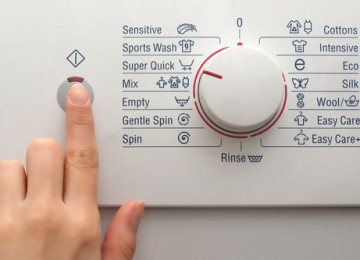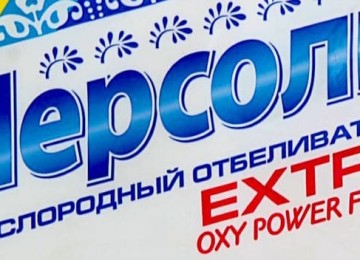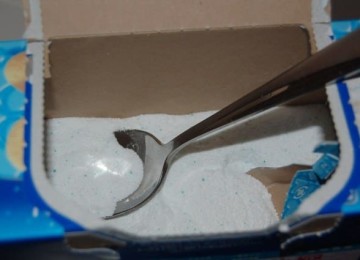 We call tulle a thin translucent material that we use to decorate the interior of a room. It prevents the penetration of direct sunlight, transforms the interior of the room, making it more cozy and comfortable. Tulle curtains look perfect, but they accumulate dust and lose their attractiveness over time. Is it possible to wash tulle in a washing machine and how to properly care for them? You will find answers to these questions in this article.
We call tulle a thin translucent material that we use to decorate the interior of a room. It prevents the penetration of direct sunlight, transforms the interior of the room, making it more cozy and comfortable. Tulle curtains look perfect, but they accumulate dust and lose their attractiveness over time. Is it possible to wash tulle in a washing machine and how to properly care for them? You will find answers to these questions in this article.
Preparing for washing
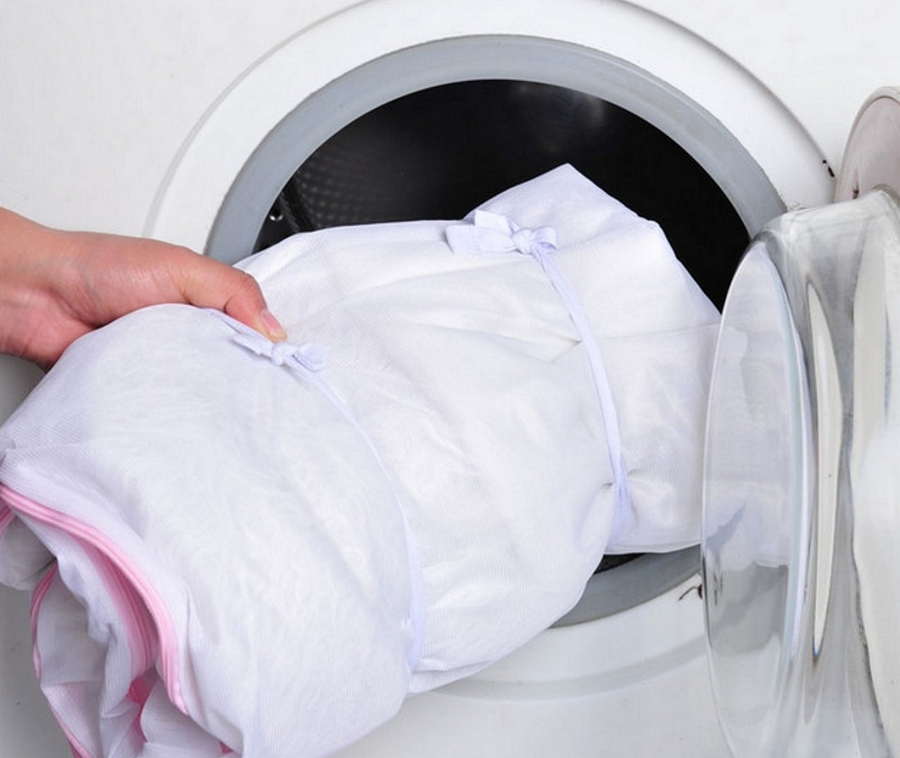
Hand washing tulle curtains is a very labor-intensive and complex process, but an automatic machine comes to the aid of modern housewives. It will provide high-quality and flawless washing, but before starting the process you need to perform the following steps:
- Shake out the dust from the curtain. Dust always settles on the mesh surface of tulle curtains. To ensure that the washing result does not disappoint and you do not have to wash the fabric again, it is advisable to shake out the curtain outside.
- Straighten it and fold it carefully.If you throw a carelessly folded curtain into the washing machine, you may find a large number of creases after washing, which even thorough steaming will not help to get rid of. That is why it is better to carefully straighten and fold the fabric.
- Let's use a special cover. Such devices will preserve the integrity of the fabric, and also protect the washing machine from breakdowns if the curtains are decorated with various small decorations in the form of sequins, beads or beads.
Type of material
Before washing tulle in an automatic washing machine, you need to determine what fabric the curtain is made of. Then, based on the composition of the material, use one or another method of caring for the product. Today, textile attributes are made from a variety of fabrics:
- Silk. This is a natural material, distinguished by its extraordinary beauty. As household chemicals, special gels or compositions for washing children's clothes are recommended, a gentle cleaning mode is used.
- Viscose. It looks impeccable, its unique shine resembles silk. The fabric requires special handling, special compositions are selected that do not contain alkali. It is afraid of the effects of hot water and air, since under their influence it rolls and shrinks, the normal water temperature is 30 degrees. It does not tolerate wringing and drying. After washing, the canvases are hung on the cornice.
- Polyester. A synthetic material that is durable and long-lasting. With proper care, it will retain its original appearance for many years. Machine washable in a standard mode, the water temperature does not exceed 60 degrees. Withstands medium heating of the iron, but the fabric must be ironed through gauze or other material.
- Nylon.Just like the previous type, it is durable and requires compliance with some care recommendations. If you neglect the temperature regime, the fabric may turn yellow. Washable in water heated to 35 degrees. Do not use chlorine-containing bleaches; the fabric can be easily cleaned even in cool water.
- Cotton. To remove stains and dirt, you can use water heated to 70 degrees, but if the fabric contains artificial fibers, then the temperature should not exceed 40 degrees. Complete removal of dust occurs only after a long wash. Sometimes bleaching agents are used to add whiteness. Such fabrics need to be starched. Drying is not allowed: damp fabric is ironed and hung.
- Organza. Such products can be washed in a gentle cycle or by hand. The temperature should not exceed 35 degrees. They do not withstand aggressive squeezing or twisting. Rubbing such material is also not recommended. If necessary, it can be ironed by setting the iron to minimum heat. Chiffon curtains are washed in the same way.
- Veils. Use a delicate washing mode with water heating up to 30 degrees. The fabric does not tolerate exposure to bleaches and other chemicals. Ironed through cotton fabric.
- Kisei. Washable in a special case at a temperature not exceeding 35 degrees. First, the threads can be braided into a pigtail. Do not squeeze, excess moisture should drain on its own. It won't iron! It is allowed to hang slightly damp threads on the cornice.
Choosing household chemicals
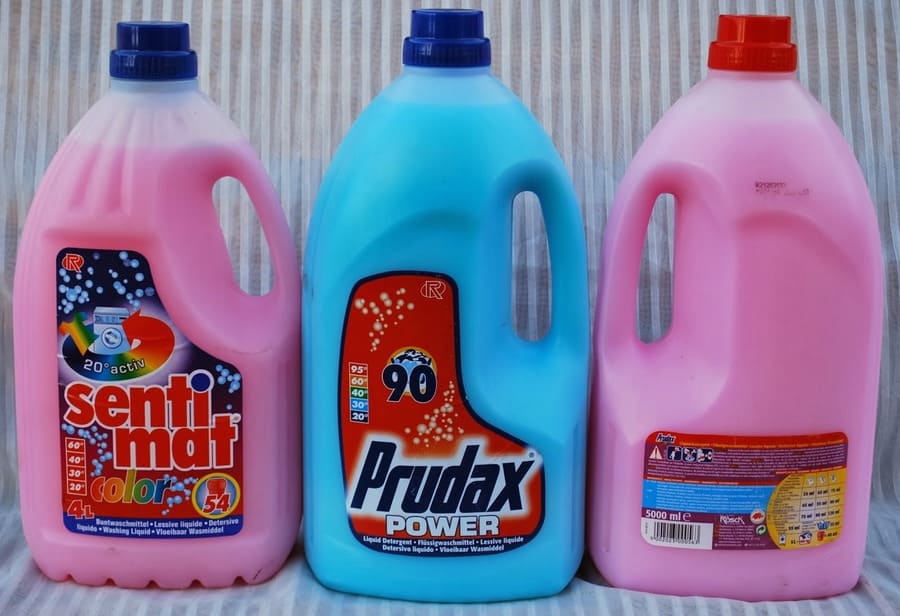
A wide range of products are available for washing tulle material.The detergent is selected based on certain characteristics of the fabric. Modern stores offer a variety of powders and gels. What to prefer and how to make the right choice?
Special products for tulle
They are especially effective as they remove all contaminants from the fibers of the mesh material. The bleaching effect and starching give the curtains an unparalleled look. Such compositions form little foam, so they can be used with confidence in automatic machines, as well as for the care of expensive fabrics. For better cleaning, use a powder enhancer.
Traditional powders
Selected depending on the color of the textile. For white fabrics, powders with a bleaching effect are needed, and for colored ones, compositions that preserve the tone of the dyed tulle material are needed.
Gels for delicate items
They are used to care for wool and other fine fabrics; they can also be used for washing synthetic tulle of various shades. Gentle gels cope with even the most severe stains in cool water. They are easily washed out without leaving streaks.
Products for children's things
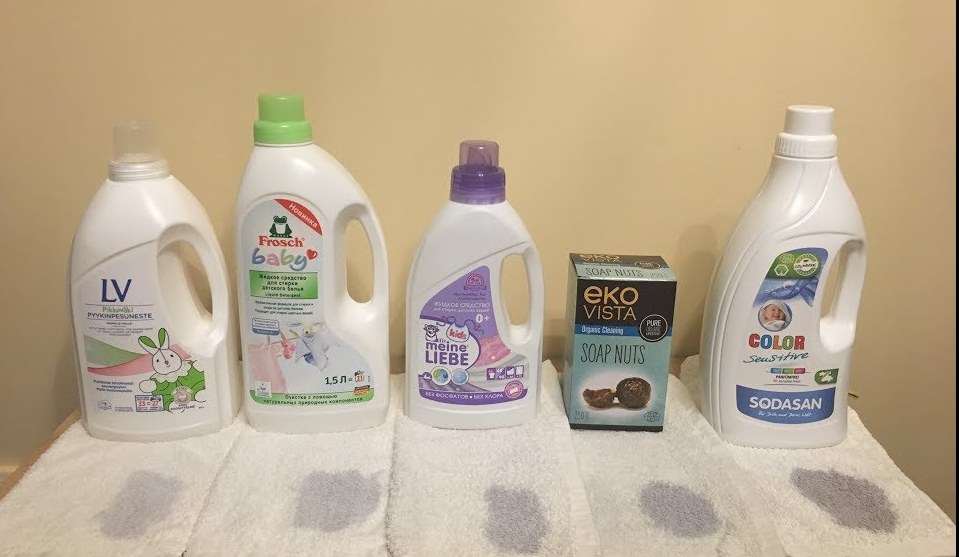
They effectively remove stains from grease, soot and other substances, wash white tulle, and do not leave streaks. It is preferable to wash cotton and synthetic fabrics, as well as kitchen curtains.
Silk compositions
To wash expensive silk tulle, it is advisable to purchase a special balm. It protects the fiber structure and successfully copes with dirt.
Washing stages

To ensure that the result of the process does not disappoint, it is important not only to use the appropriate product, but also to organize your actions correctly and choose the appropriate machine wash parameters.The use of household appliances can make the work of housewives easier, but they are required to know some nuances and follow the sequence of actions when washing by machine. What stages does the process consist of? So, we proceed as follows:
- Pour or pour the detergent into the designated compartment. You should not fall asleep in excess; half the usual dosage is enough. The fact is that the material is quite light, so if the drum is not fully loaded and there is too much powder, too much foam will form.
- We present the program. Select the temperature mode and other parameters, press the “Start” button.
- We take the product out of the washing mashine.
- Let the water drain. Under no circumstances should we twist or wring out the tulle, as this will cause folds and creases. Do not dry completely.
- Iron wet tulle using low temperatures. We remember that when the iron heats up too much, the fabric turns yellow.
- We hang slightly damp curtains on the cornice.
Setting machine wash parameters
If the settings are incorrectly selected, there is a high probability that after washing the curtains will go to the trash bin. That is why we take this very seriously.
Water temperature
Selected based on the type of tulle material. It must be remembered that it is very delicate, so when exposed to high temperatures the following occurs:
- the material is deformed;
- yellowness appears on the surface of the fabric, which is not removed when using even the most effective bleaches;
- synthetic fabrics are covered with pellets.
Experts advise washing even the most inexpensive synthetic curtains at low temperatures not exceeding 40 degrees.
Process duration
When choosing this option, it is important to maintain a balance, because if time is limited, the dust will not be completely washed off. However, intensive washing is also not required - dirt is easily removed from the thin mesh material. The machine program provides for a gentle mode; it is better to give preference to it.
Extra rinse
Selecting this option is encouraged, as chemical residues on the fabric will cause premature yellowing. Thorough rinsing will ensure a well-groomed appearance of the fabric without streaks and stains.
Spin
It is advisable to wash tulle material without spinning and at minimum speed. There is no need to worry that the openwork patterns and delicate weave of threads will not be damaged after such a procedure. Curtains hang on the curtain rod even without ironing.
Soak
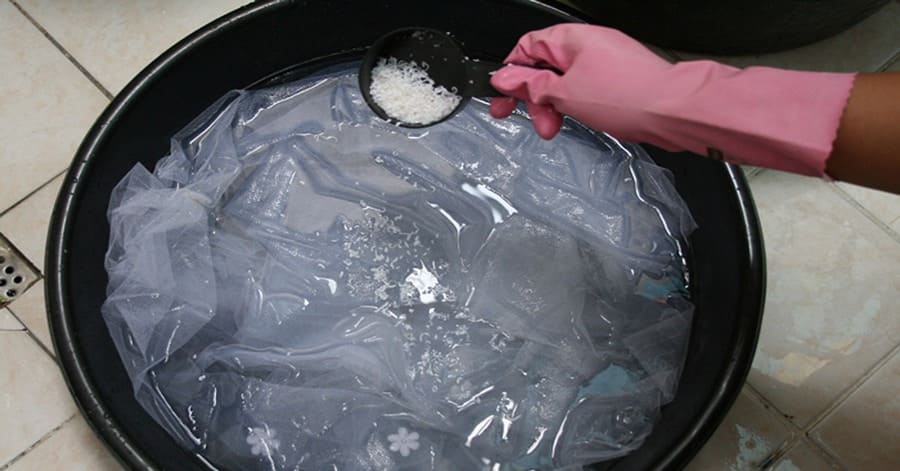
Soaking curtains in water with added cleaning agents significantly improves the quality of cleaning. Housewives have armed themselves with some tricks and use them to give the curtains a white and well-groomed appearance. So, the following proven recipes are used to remove stains and other contaminants.
Method 1
We proceed as follows:
- Dissolve one spoon of ammonia and two spoons of hydrogen peroxide in a bucket of hot water.
- Stir the composition and immerse the tulle.
- Let stand for 15-20 minutes.
- Rinse well and wash by hand or machine.
Method 2
It is used to remove yellowness and greasy stains and consists of the following:
- Mix two tablespoons of soda in 100 grams of powder.
- Pour the mixture into a bowl of warm water.
- Stir and lower the curtains.
- Let stand for 30 minutes.
- Wash by hand or machine.
Whitening
Sometimes classic detergents cannot cope with the gray coating on fabrics, so bleaching agents are used to give dazzling whiteness. It is worth noting that compositions containing chlorine should be excluded, as they can deform delicate tissue. So, it is better to turn your attention to one of the following remedies:
- Bleach for curtains. Designed taking into account the mesh structure of the fabric. Its use is safe and especially effective.
- Oxygen compounds. Suitable for cleaning kitchen textiles. They are versatile and effectively deal with stains even at low temperatures.
- Blue. It is an optical brightener that removes yellowness from fabrics. A weak blue solution is poured into the balm compartment; you can add a small amount of grains.
- Salt. It is a folk remedy for fighting stains. A couple of tablespoons of salt are added to the washing powder.
Rinsing
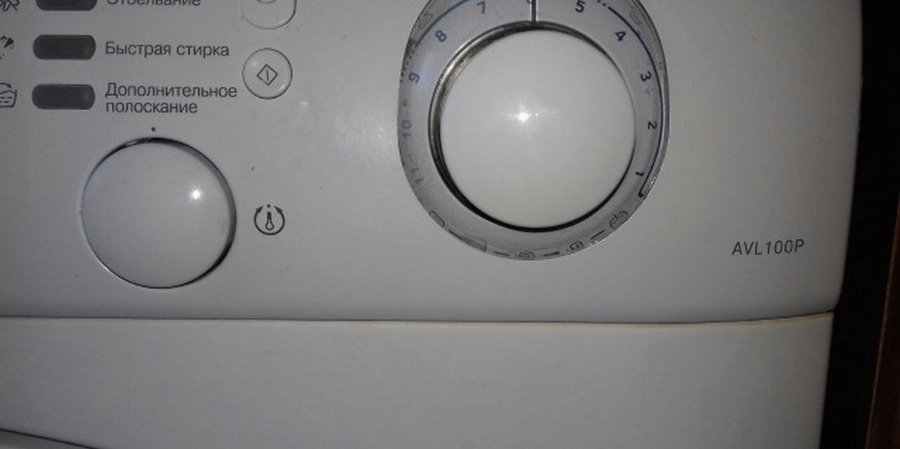
To ensure that all detergent particles are washed out of the fabric fibers, it is advisable to select an additional rinse when machine washing. Some housewives, to give the fabric an attractive appearance, pour salt solutions and starch compositions into the rinse aid compartment. After finishing the machine rinsing, you can additionally rinse the curtains in water. The following proven method will help not only remove particles of gel or powder from the fabric, but also return the curtains to their dazzling whiteness.
Rinse in water with added greenery
We prepare the composition like this:
- Add 15 drops of brilliant green to a solution of salt and water, taken in a proportion of 2 spoons per 500 ml.
- Mix everything thoroughly and wait about 5 minutes for a precipitate to form.
- We strain the solution to remove settled particles, as they can stain the fabric.
- Add the liquid to the rinse water.
- We dip the curtains by carefully turning them over and squeezing them lightly. This is done so that the composition evenly penetrates the fibers.
- We straighten and hang. We do not twist it under any circumstances.
Removing stains
Often difficult-to-remove stains form on tulle, so every housewife may have doubts: will ordinary powder cope with such stains? Before putting the curtain into the machine drum, you can use one of the methods to remove stains:
- Saline solution. Mix one spoon of salt in a glass of warm water, then immerse the contaminated areas in it for 3 hours. Salt perfectly removes dirt and even removes blood stains.
- Starch. The stain on the dry curtain is generously sprinkled with powder, after a while it is shaken, and the contaminated area is washed with bleaching soap.
- Soda Ash. Contaminated areas of fabric are immersed in a mixture of water and one spoon of soda. In case of persistent contamination, the solution is changed several times.
- Gruel for removing grease stains. It is obtained by mixing equal proportions of soda and salt. Then vinegar and a few drops of ammonia are added to the mixture. The resulting slurry is used to treat the contaminants and leave for 5-10 minutes. Then the product is washed in a washing machine.
Ingredients for preparing stain removers can be found in any household. The recipes are quite simple, and the effect after using such products will be amazing.In addition, in stores you can find special products for treating stains; they must be used according to the instructions.
Starching

Natural fabrics are very capricious and do not retain their shape, so it is recommended to iron and starch them. Starched thin cotton curtains look especially beautiful; they form lush folds that last a long time.
The advantages of this process are as follows:
- the material does not wrinkle and looks beautiful;
- the resulting film protects the fabric from the penetration of dust and dirt into the fibers;
- starch is quickly washed out during subsequent washing, so dirt is removed immediately;
- there is a whitening effect.
It is allowed to starch cotton and linen products, but silk and synthetic fabrics are not treated with similar compounds.
The starch composition can be purchased at the store, or you can prepare it yourself. It is poured into the rinse aid compartment, and if it is used, then no other rinse aid is used. Before trying store-bought formulations, you should read the instructions. Well, at home the solution is prepared in the following way:
- Dissolve starch in cold water: take one spoon of powder for one glass of liquid.
- Pour one glass of boiling water into the resulting mixture in a thin stream, stirring it constantly.
- Boil the mixture until a clear mixture is obtained.
- Let it cool and remove any lumps if they have formed.
- The composition is ready for use.
Important! To process tulle material, it is advisable to use corn starch, since potato starch turns yellow when exposed to sunlight.
Useful tips
Some recommendations from experienced housewives will help young girls cope with the difficulties that arise when running a household and caring for textiles:
- Tulle curtains should be washed once a quarter. This will help avoid stubborn stains. If the windows overlook a highway or an area with busy traffic, or if one of the family members suffers from allergies, then the frequency of washing should be increased.
- You should not stuff delicate items into the drum. They need to be carefully straightened, folded, and packed in a special mesh bag. If you don’t have it on hand, then you can use a regular pillowcase with a clasp.
- Before sending curtains into the machine drum, be sure to remove hooks and other parts that can lead to damage to the material or household appliances. The eyelets do not need to be removed if a special cover is used.
- The curtains are hung vertically and first folded several times. They are left until all the water has drained.
- If the product has stains that are difficult to remove and cannot be cleaned, or the appearance of the tulle leaves much to be desired. And I don’t really want to throw it away. Then coloring substances, which are present in a wide range on store shelves, will come to the rescue.
Tulle curtains are an integral attribute of any interior. Snow-white and well-groomed canvases add solemnity to the room, making it cozy and bright, while untidy curtains will spoil the overall impression - even the most elegant room will seem unattractive and gloomy. With proper care of tulle and following all the recommendations outlined, it is possible to maintain its magnificent appearance for a long time!







